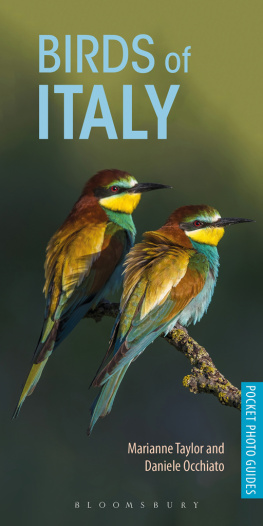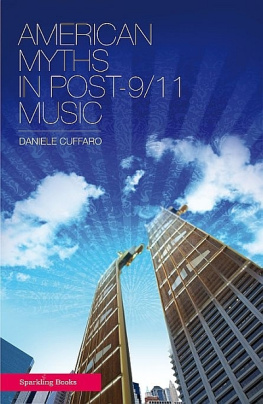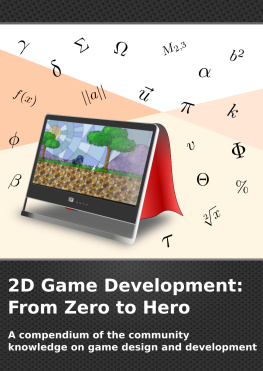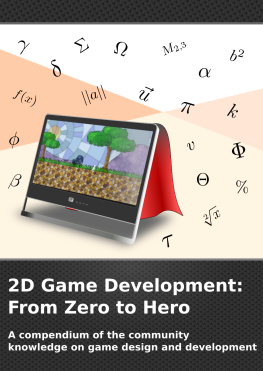Occhiato Daniele - Birds of Italy
Here you can read online Occhiato Daniele - Birds of Italy full text of the book (entire story) in english for free. Download pdf and epub, get meaning, cover and reviews about this ebook. City: Italy, year: 2018, publisher: Bloomsbury UK;Helm, genre: Home and family. Description of the work, (preface) as well as reviews are available. Best literature library LitArk.com created for fans of good reading and offers a wide selection of genres:
Romance novel
Science fiction
Adventure
Detective
Science
History
Home and family
Prose
Art
Politics
Computer
Non-fiction
Religion
Business
Children
Humor
Choose a favorite category and find really read worthwhile books. Enjoy immersion in the world of imagination, feel the emotions of the characters or learn something new for yourself, make an fascinating discovery.
- Book:Birds of Italy
- Author:
- Publisher:Bloomsbury UK;Helm
- Genre:
- Year:2018
- City:Italy
- Rating:5 / 5
- Favourites:Add to favourites
- Your mark:
- 100
- 1
- 2
- 3
- 4
- 5
Birds of Italy: summary, description and annotation
We offer to read an annotation, description, summary or preface (depends on what the author of the book "Birds of Italy" wrote himself). If you haven't found the necessary information about the book — write in the comments, we will try to find it.
Birds of Italy — read online for free the complete book (whole text) full work
Below is the text of the book, divided by pages. System saving the place of the last page read, allows you to conveniently read the book "Birds of Italy" online for free, without having to search again every time where you left off. Put a bookmark, and you can go to the page where you finished reading at any time.
Font size:
Interval:
Bookmark:


HELM
Bloomsbury Publishing Plc
50 Bedford Square, London, WC1B 3DP, UK
This electronic edition published in 2018 by Bloomsbury Publishing Plc
BLOOMSBURY, HELM and the HELM logo are trademarks of
Bloomsbury Publishing Plc
First published in Great Britain, 2018
Copyright Text by Marianne Taylor, 2018
Photographs Daniele Occhiato, 2018 (except where otherwise listed )
Marianne Taylor has asserted her right under the Copyright, Designs and Patents Act, 1988, to be identified as Author of this work
For legal purposes the constitute an extension of this copyright page
All rights reserved
You may not copy, distribute, transmit, reproduce or otherwise make available this publication (or any part of it) in any form, or by any means (including without limitation electronic, digital, optical, mechanical, photocopying, printing, recording or otherwise), without the prior written permission of the publisher. Any person who does any unauthorised act in relation to this publication may be liable to criminal prosecution and civil claims for damages.
Bloomsbury Publishing Plc does not have any control over, or responsibility for, any third-party websites referred to or in this book. All internet addresses given in this book were correct at the time of going to press. The author and publisher regret any inconvenience caused if addresses have changed or sites have ceased to exist, but can accept no responsibility for any such changes
A catalogue record for this book is available from the British Library
Library of Congress Cataloguing-in-Publication data has been applied for
ISBN: 978-1-4729-4982-0 (PB)
ISBN: 978-1-4729-4983-7 (eBook)
Designed by Susan McIntyre
To find out more about our authors and their books please visit www.bloomsbury.com where you will find extracts, author interviews and details of forthcoming events, and to be the first to hear about latest releases and special offers, sign up for our newsletter.
CONTENTS

INTRODUCTION
Italy marks the transition from south-western to south-eastern Europe. The country comprises the mainland with its elegant high-heeled boot outline, which stretches south-east into the Mediterranean, along with the major islands of Sicily and Sardinia (plus a few groups of smaller islands). With its generally warm climate, varied and spectacular scenery, famous cityscapes and unique archaeological wonders, Italy is an extremely popular destination for tourists.
The history of Italys wild places and wildlife has not been an entirely happy tale. Rapid industrialisation led to pollution, forest clearance, rapid development of formerly wild coastlines and the loss of vast tracts of habitats, while efforts to reduce the hunting of wild birds has met with strong resistance from a powerful gun lobby. However, much of Italys wild beauty has survived intact, and conservation progress since the 1990s has been considerable. There are now 25 national parks in Italy and these, along with other protected areas, cover more than 11% of the total land area. One third of animal species native to Europe can be found in Italy, and about 540 bird species have been recorded here well over half of all species recorded in Europe as a whole, although many of these are vagrants rather than regular visitors. This book covers the most frequently encountered or distinctive birds of Italy 256 species in all. For an exhaustive guide to all species ever observed in Italy, we recommend Collins Bird Guide (2009) see .
HOW TO USE THIS BOOK
This pocket guide is designed to be a quick and easy reference book for anyone birdwatching in Italy. The introductory section presents general information, including types of habitat, some of the best birdwatching sites, and general guidance for birdwatching in the country. This is followed by accounts for individual species, arranged by family. A glossary covering basic terminology is included towards the back of the book.
Each account is illustrated with one or more colour photographs, showing the bird as it will be encountered in Italy so winter visitors are shown in winter plumage, summer visitors in breeding plumage, and where the sexes differ significantly, male and female plumages are shown. The images show wild birds photographed in Italy, and are chosen to show a clear view in natural viewing conditions, with good natural light.
The text describes the birds appearance in all plumages likely to be seen in Italy, highlighting key features that will particularly aid identification. Songs and calls are then described, followed by information on the birds habitat preference in Italy, any notable behavioural details, and finally an outline of its distribution, abundance and seasons of occurrence. For those species assigned a conservation status of Near Threatened or Vulnerable by the International Union for Conservation of Nature (IUCN), this is mentioned in brackets at the start of the account. A few technical terms are used to save space but all are explained fully in the glossary.
BIRD TOPOGRAPHY
The illustration below shows a quick guide to body parts and feather groups referred to in the species accounts. An understanding of these terms will be useful for identification purposes.

HABITATS
Italys shape and location gives it considerable variation in climate from north to south. The land profile also varies a great deal much of the mainland is hilly or mountainous but there are also some important lowland wetlands, and more than 9,000km of coastline. The two major islands, Sicily and Sardinia, have their own particular geographic character and wildlife.
Mountains Italys northern edge is marked by the Alps, Europes highest and most significant mountain range. A few cold-climate montane species, such as Ptarmigan, occur only here, while other mountain-dwelling birds can also be found in the Apennines further south, in the uplands of the south, and on Sicily and Sardinia.
Forest There are significant remnants of primeval deciduous forest in Calabria and Tuscany, while in the alpine regions there are forests of fir and pine, home to Capercaillies, Nutcrackers and many more birds. The Apennine foothills support interesting woodlands of Neapolitan maple and Italian alder. On Sicily, Sardinia and the southern mainland, woodland is dominated by Mediterranean species such as cork oak and Aleppo pine.
Scrub/maquis Where forest has been cleared, or the soil does not support its growth, a mosaic of bushes and tall herbaceous plants may grow. This is rich in insect life and accordingly supports a great range of bird species, including various species of shrikes and Sylvia warblers. Maquis scrub, consisting mainly of thick evergreen shrubs like broom and myrtle, is common in the south and on Sicily and Sardinia.
Meadows and cultivated land Untouched grassland is scarce in Italy but alpine meadows offer great hunting grounds for birds and other wildlife, especially butterflies. Vineyards, olive groves, grazing land and other farmland can also be productive for open-country and scrubland birds.
Font size:
Interval:
Bookmark:
Similar books «Birds of Italy»
Look at similar books to Birds of Italy. We have selected literature similar in name and meaning in the hope of providing readers with more options to find new, interesting, not yet read works.
Discussion, reviews of the book Birds of Italy and just readers' own opinions. Leave your comments, write what you think about the work, its meaning or the main characters. Specify what exactly you liked and what you didn't like, and why you think so.












